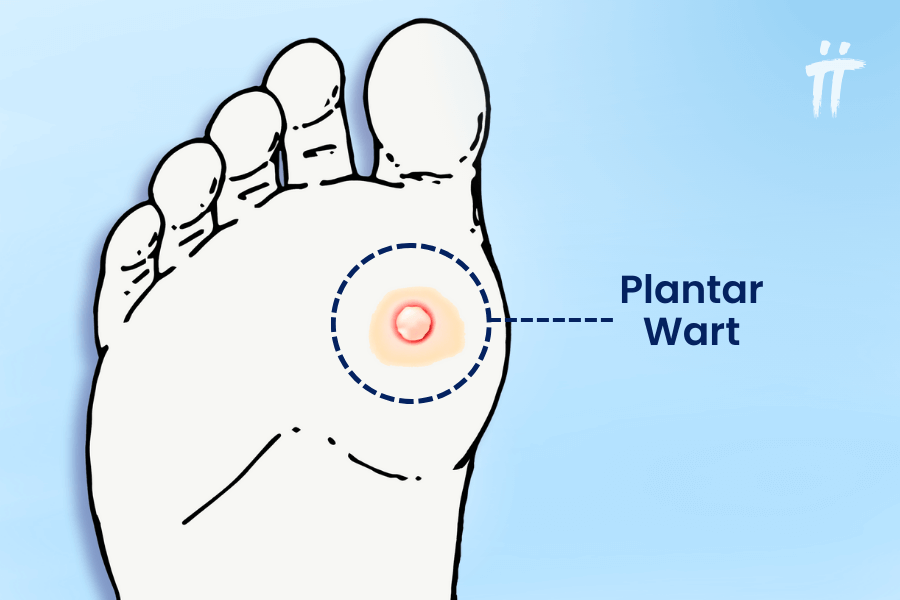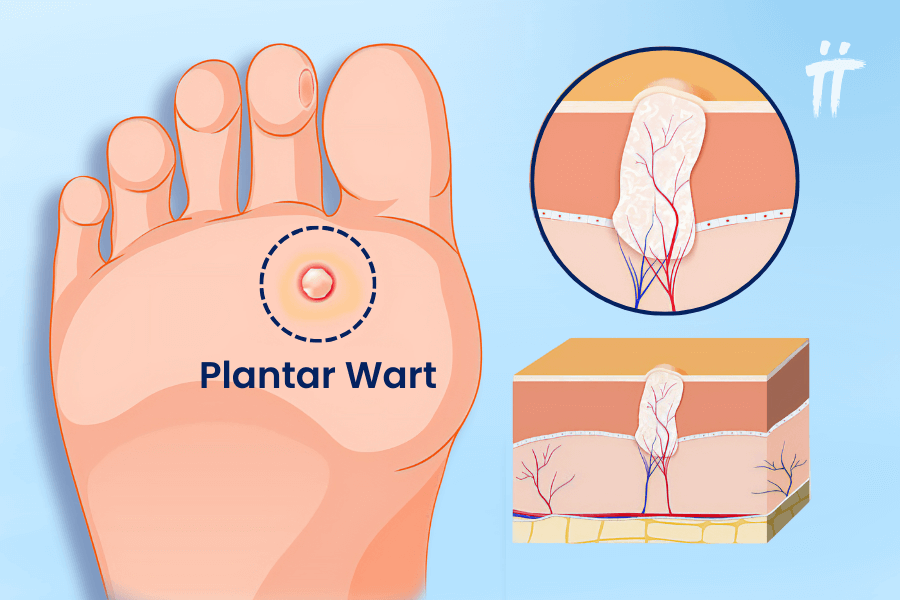
Warts are raised growths on the skin caused by a type of virus called human papillomavirus (HPV). Warts are a problem that has plagued people for thousands of years. Warts have been discovered on 16th century mummies and even on 3000-year-old mummies.
A type of virus called HPV enters the body through cracked skin and infects the upper layer of the skin, where it causes warts to form. Most warts can become a stubborn skin problem that does not go away for months and years. Warts can occur anywhere on the body, most commonly on the hands and soles of the feet.
Usually warts can be contagious, although this is not a dangerous condition. However, they can be painful and agonizing at times, as well as aesthetically unpleasant for many patients. The treatment of warts requires a long process and may not always give definitive results. However, today, thanks to new technologies and methods, there are promising solutions for the treatment of warts.

Warts and Plantar Warts
Warts and Plantar Warts
Warts are caused when a type of virus known as Human Papilloma Virus (HPV) enters the body through small cuts and cracks in the skin. Warts can occur anywhere on the body and there are different types. Each type of wart occurs on a different part of the body and has a different appearance.
- Common warts: Common warts usually grow on the fingers or toes. They are rough and round bumps on the skin. They may have a more gray appearance than normal tissue.
- Flat warts: Flat warts usually occur on the face, thighs or arms. These warts are usually small, not immediately recognizable and have a smooth texture, as if they have been scraped off. They may appear pink, brown or slightly yellow.
- Filiform (filiform) warts: Filiform warts grow around the mouth or nose, sometimes on the neck or under the chin. Small filamentous warts are the same color as your skin.
- Periungual warts: Periungual warts grow under and around the fingernails or toenails. This type of wart can be painful and can affect nail growth.
- Plantar Warts: Plantar warts, that is, warts on the soles of the feet, are a type of wart that occurs on the soles of the feet. Unlike other warts, plantar warts usually grow inwards rather than outside the skin. It appears as a small spot on the bottom of your foot surrounded by hardened skin. Plantar warts can cause discomfort when walking and moving.
Plantar Warts (Warts on the soles of the feet)
Plantar warts, or warts on the soles of the feet, usually appear on the heels or other weight-bearing areas of your feet. Pressure on the soles of the feet can cause plantar warts to grow inward under a hard, thick layer of skin (callus).
Warts on the soles of the feet are caused by HPV (human papillomavirus), just like other types of warts. This virus thrives in warm and humid places such as changing room floors and swimming pools. Small puddles, especially around pools, are a good breeding ground for HPV.
HPV is a very common group of viruses and there are more than 100 types of HPV viruses. But only a few cause warts on the feet. The virus can be transmitted by direct contact and can find an easier entry route into the body if you have a cut or crack in your foot. Warts can develop anywhere on the foot, but they typically appear on the bottom (plantar side) of the foot. Plantar warts commonly occur in children, adolescents and the elderly.
Most warts on the soles of the feet do not pose a serious health problem. Some warts disappear on their own over time, while others may not go away for months or even years. Warts on the soles of the feet may cause discomfort when walking and moving, and may occasionally cause aches and pains. In addition to these, it can be aesthetically uncomfortable for many people.
The symptoms of a wart on the soles of the feet can be different. Some are a single wart, which usually grows over time and can multiply to form additional warts. Mosaic warts are clusters of several small warts growing close together in one area and are more difficult to treat.For the treatment and care of a wart on the soles of the feet, you should definitely seek help from your doctor.
Plantar Wart (Warts on the Soles of the Feet) Symptoms
Plantar warts can be painful. One of the symptoms of a plantar wart is pain or tenderness when you put pressure on your foot while walking. When a wart forms, you notice a circular flat spot on the skin with a dimpled area in the center. Depending on the color of the skin around it, the wart may look yellow, have a scab or have a black spot in the middle. The symptoms of a sole wart are generally as follows;
- A small, fleshy, rough growth (lesion) on the bottom of your foot, usually at the base of the toes and forefoot or on the heel,
- Hard and thickened skin over the point where the wart grows inwards (callus),
- Black dots with small, clotted blood vessels, called wart seeds,
- Pain and tenderness when walking or standing.

Is Plantar Wart (Warts on the Soles of the Feet) Contagious?
The types of virus that cause plantar warts may not always be transmitted by direct contact. This means that the virus may not be easily transmitted from one person to another through direct contact. However, each person’s immune system reacts differently to HPV.
Warm and humid environments, such as in pools and changing rooms, are common growth conditions for the virus. Walking barefoot in these environments can increase the risk of warts. Also, some people are more likely to get warts than others.
Who is at Risk for Warts?
Warts on the soles of the feet can occur in anyone. But children and young people in particular are more likely to be affected by these warts. However, people with weakened immune systems, people with a history of plantar warts, and people who walk barefoot in places where exposure to the wart virus is common may be at greater risk of developing plantar warts.
If the wart is bleeding, painful and discolored, if it recurs and multiplies despite treatment, or if you experience a loss of sensation in your feet as well as diabetes, it is strongly recommended that you consult a doctor. It should not be forgotten that especially diabetics should be very careful and attentive about their feet and foot health.
Plantar Wart (Foot Sole Warts) Treatment
Because warts on the soles of the feet grow under the skin, it can be difficult to tell how big the wart is without an examination. Over time, the wart can cause pain and spread to other areas. It is therefore important to consult a doctor if you suspect you have a wart.
To diagnose a plantar wart, the foot and ankle surgeon examines the patient’s foot and the signs of the wart, looks for the presence of small clotted blood vessels and, if necessary, may remove a small section of the lesion (biopsy) and send it to the laboratory for analysis. This will diagnose whether you have a plantar wart and, depending on the size of the wart, determine the best treatment for you.

Treatment of warts on the soles of the feet includes topical or oral treatments, laser therapy, cryotherapy (freezing), acid treatments or surgery.
- Treatment with salicylic acid: Salicylic acid has a strong exfoliating effect and prescription wart medications containing salicylic acid work to remove layers of warts on the skin. It is used as a topical cream that can “burn” warts. They can also stimulate your immune system’s ability to fight the wart.
- Cryotherapy: Cryotherapy is the process of freezing the wart by applying liquid nitrogen to the wart with a spray or cotton swab. Your doctor may combine different treatments such as cryotherapy and salicylic acid for more effective results.
- Laser treatment: In wart treatment, the laser method aims to close the blood vessels that feed the wart. The infected tissue loses its vitality at the end of the laser treatment and the wart disappears.
- Surgical treatment: When methods such as salicylic acid application or freezing the wart do not produce results, the wart can be removed by surgical procedures. In surgical wart treatment, the wart can be cut out or burned with electric current (electrocauterization). Surgical procedures may be more painful than other treatment methods and may cause scarring. For this reason, surgical methods are generally not preferred for the treatment of plantar warts.
The aim of treatment for warts on the soles of the feet is to completely remove the wart. However, even if it seems like a minor skin problem, most of the time the treatment of warts is difficult and requires a long process. Despite repeated treatments, over time the wart can reoccur and become a problem for patients again or spread to other parts of the body.
Thanks to the technology and methods developed today, new effective solutions have been found against warts: Wart treatment with microwave technology.
New Method in Wart Treatment: Microwave Treatment
As with warts on the soles of the feet, the infected tissue can be found a few millimeters below the skin surface. Therefore, in order to treat the wart effectively, it must be treated by reaching a certain depth. In the new and pioneering system developed, warts are treated using microwave energy. As microwave energy enters the tissue, water molecules try to align with the microwave field, causing the water molecules to collide with each other and create friction. Thus, a highly sensitive treatment area is provided with the heat generated.
Using microwave energy, the new system provides a precise and highly controlled dose of energy that rapidly raises tissue temperature. The treatment is completed in seconds and the healing process begins immediately. The treated tissue is rapidly repaired and regenerated. Thus, microwave therapy offers a new, precise and easy way to treat tissue lesions. This procedure, which does not require anesthesia and post-procedure dressing, provides a clean and safe treatment opportunity.

Plantar warts are a fairly common problem. Although it may seem like a minor skin problem, there is no single treatment that is always effective. Often, despite treatment, warts can reoccur and cause discomfort to the patient. Remember that trying to treat warts without the help of a doctor can do more harm than good.
Frequently Asked Questions About Warts on the Soles of the Feet
What happens if the wart is not treated? Can a wart on the foot spread elsewhere?
If plantar warts are left untreated, they can spread rapidly to other parts of the foot or body and infect other people. Left untreated, warts can last from a few months to 2 years in children and several years in adults. In addition, pain can be seen in plantar warts that are left untreated for a long time, and this can affect people’s posture or gait, causing muscle or joint discomfort.
Is a wart on the foot dangerous? Which warts are dangerous?
There are more than 100 types of the HPV virus that causes warts. Some HPV viruses cause warts on the hands and feet, while other types of HPV viruses cause warts on or around the genital organs (genital warts). Most warts on the soles of the feet do not pose a serious health problem. However, warts in the genital area and especially on the cervix can be dangerous and can develop into cervical cancer.
How do we recognize a wart on the foot?
A small raised bump on the bottom of the foot, the base of the toes or the heel; a darker than normal skin color; thickened skin (callus) at the point where the wart grows inwards; blackheads with small clotted blood vessels; and pain when walking or standing are often indicators of wart formation.
How can you remove warts at home?
For the treatment of warts at home, there are various treatment options available in pharmacies, such as wart pads, creams and salic acid, as well as traditional folk methods (fig swarm, toothpaste, etc.). However, unfortunately, these methods are not effective in completely treating the wart and solving the condition that causes the wart. For this reason, it is recommended that you consult a podiatrist who is an expert in the field and knowledgeable about new treatment options for the treatment of your wart.
Is foot wart sexually transmitted?
There are more than 100 types of Human Papillomavirus (HPV). About 40 of these can infect the genitalia (vulva, vagina, cervix, rectum, anus, penis and scrotum), mouth and throat. These types of HPV virus can be transmitted during sexual contact. However, other types of HPV virus that cause warts on the hands and feet are not sexually transmitted.
You can also make an appointment with our specialist doctors before the wart/warts on your foot cause more serious health problems. You can review the frequently asked questions in the rest of our article and contact us for additional questions.









Leave a Comment